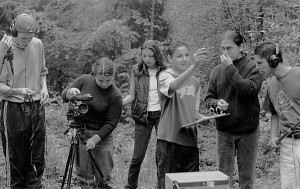New Views
by Deblekha Guin

First Nations youth on "location"
New Viewsby Deblekha Guin |
|
This fall the Access to Media Education Society (AMES) ran the 2nd annual New Views video intensive programme which gave 54 multicultural, First Nations and street-involved youth a chance to find a voice of self representation and ultimately self empowerment.
During each of the three one-week programmes, 18 youth worked closely with accomplished film makers and other youth from their communities to create a series of short videos from start to finish. Working in teams of three, each person got hands- on experience in every facet of the production process - from script writing and acting to directing, camera, lighting, sound design and non-linear editing.
The students are not just involved in everything from the initial brainstorming session to the final mix, they are in the driver's seat. This respect for the student's creative autonomy is part of what makes New Views so successful. The students left not only with an original video to show family and friends, enter into festivals and use to support job applications, but an enduring sense of empowerment.
Over the course of the '98 programme, 54 youth created a total of 24 courageous, innovative and at times humorous short videos. These videos stand as powerful testaments to the creative poten-tial that is unleashed when youth who are generally denied a voice in the mainstream are given the tools to tell their own stories.
Since the fall of 1997 this ground-breaking programme has given over 125 youth from typically under-represented communities the tools to have their voices heard and their visions seen.
Deblekha Guin is the Project Coordinator of New Views and Executive Director of Ames.
TANIA WILLARD IS FROM THE SHUSWAP NATION |
SIRRAK CHERBOURD, GRADE 12 STUDENT |
|
Voices:What motivated you to take part in the programme? Tania: Mainly being able to connect with First Nation youth and take part in what we deal with in our lives. For instance, being of mixed blood, there were some people there who could identify with those issues, such as having to prove yourself, because you visibly don't fit in. I joined the project with the view of first listening to what people had to say and allowing myself to learn from the process. What was the result of the video that you worked on? Two other people and I produced a video called May'axal which is a Kwakwala word for respect. It was an experimental piece that dealt with stereo- types and how people often are not aware of them because they believe the stereotypes as they are so saturated by media. More importantly, we interviewed other participants about combating those stereotypes. How has the experience of making May'axal affected your perspectives around the issue of stereotypes? It made me want to work more with indigenous media, continuing with my radio show and pursuing other areas. I realized what an amazing apportunity it is to be able to tell your stories because those stories aren't represented on mainstage media, or maybe rarely, in the context of Dances with Wolves or something like that. The point was driven home to me how important it is to have First Nations voices in the media, to have First Nations being able to controlthat media. To pursue that, I'll be going to the Shuswap and Adams Lake First Nations and giving a workshop on indigenous media, the process of setting up a radio station, etc. It is important for First Nations and also for non Native people to have more education about First Nations and the rich tapestry of their culture. That sort of stuff won't come over the news about the Nisga'a but you'll get that from the guy in Port Alberni telling what it was like for him growing up, how he wanted to be white, bleaching his skin, and stuff like that, that's a powerful story. What had the most impact for you over the six day project? The last talking circle was a personal sharing about how everybody was feeling. This is where I realized the power of giving people an opportunity to have that voice. |
Voices:Why did you participant in New Views? Sirrak: I thought it would be a completely new experience. I was very nervous at first because the others were much older than me. But when I met people I realized they were exactly like me, the age difference didn't matter. What was it like working in an intense six day project with people from other cultures than yourself" It was very hard in some ways because we had different views, different ways, different experiences but we had to find a way to work together. Your video dealt with the problem of drugs and youth; after producing the video what are your thoughts on those issues? It has made me think of how much of this is going on in the schools and on the streets and that I need to do something about it. I will try to show the video and combine it with a kind of workshop to go with it. Already I have shown the video to a multicultural youth group and I'm hoping to be able to show it at schools. |